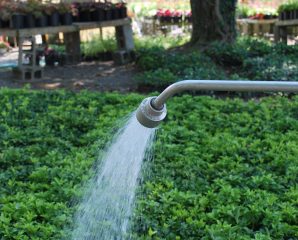First let’s take a look at the plants being planted, which are basically B&B trees and container plants. When a tree is dug, many of the roots get cut. Since it’s the fine root tips that absorb most of the water from the ground, the tree has limited ability for getting moisture through the roots until they’ve had a chance to regenerate, which usually takes weeks. Container grown plants are not as bad in terms of roots being cut. In addition, potting mixes, which are very light and coarse textured dry out quickly, even once planted in the ground, before the roots have reached out into the surrounding soil. This means that the plant could dry out in hours even when the surrounding soil is wet.
Something else to remember are transpiration rates, or water loss from the leaves and needles. Many trees, like hemlock for instance, have been sheared to be very full which causes a high rate of transpiration. However, the roots have been cut and now have a limited ability to absorb moisture from the ground to supply the leaves – not a good combination. (Remember, a 6′ Hemlock can easily transpire a gallon of water an hour into the air.)
So the key for a newly planted tree is to keep it hydrated while roots are regenerating. This might even mean spraying or misting the canopy with just a fine mist to prevent the tops from drying out while the roots regenerate.
Obviously ground moisture is important, but over-watering can be bad. Why? It fills in the air spaces (pores and capillaries in the soil) obstructing oxygen from getting to the roots. The plant can actually wilt while sitting in water logged soil. This condition can be exacerbated if there is a lack of site preparation, where the soil has poor drainage, or the tree is planted too deeply.
For me, watering is simply keeping the plant hydrated while still providing oxygen to the roots.

